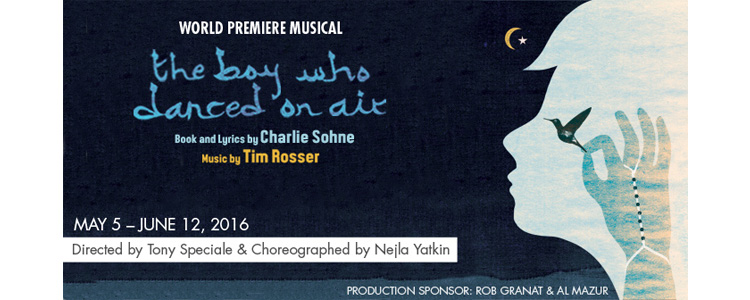This month, we chat with Festival Alumni Charlie Sohne and Tim Rosser about their 2013 Festival Show, The Boy Who Danced on Air, which is heading to Diversionary Theatre in San Diego this May. This production of The Boy Who Danced on Air is supported by a NAMT National Fund for New Musicals Production Grant, and the show previously received a Writers Residency Grant at New York Theatre Barn.
What was the post-Festival response like to The Boy Who Danced On Air?
Charlie Sohne: I think the big response that we got coming out of the Festival was, “I want to see it with dance!” The world of the show features quite a bit of dance and, beyond that, dance is a fundamental element of how we tell this story — so it was really important to start developing what the choreographic language of the piece was going to be like. We were fortunate enough that right out of the Festival New York Theater Barn (which has long been a really wonderful advocate for the piece) put together a dance workshop for us. It was really exciting to see the work leap off the page and become something more heightened than just a script with music.
Tim Rosser: Since the dance element is so central to the show and was certainly going to require a special touch, we went on a bit of a quest to find the right choreographer. Charlie saw an ad for this piece that Nejla Yatkin was working on called “Oasis: Everything You Wanted To Know About The Middle East But Were Afraid To Dance.” I remember being taken by not just by the beauty of the dance, but by the fact that Nejla often uses clear linear narratives in her dance pieces, which isn’t always the case in modern dance but is, I think, a great advantage in musical theatre. We sent her the script immediately afterwards.
What work has been done on the show since the 2013 Festival?
CS: A lot of the script work that’s been done has focused on establishing the world of the show. It’s a small show — there are only five actors — which gives it a wonderfully intimate feel, but has made it hard in the past to establish the context that these characters were operating in. Once we were able to see parts of the musical on its feet, however, we started to get a lot of ideas of how we could accomplish what we needed to do in a fresh and exciting way. Thankfully NAMT gave us a Writers Residency grant that gave us the time and space to then rewrite the opening: now it’s a sweeping number that involves a lot of movement and staging and theatricality and I think does a pretty successful job of making you feel immediately like you know the rules of the world and what the perspective of the characters are. We’ve also done quite a bit to expand one character in particular, which I think really heightens a few of the Act II twists.
TR: We presented the show with a band of three for NAMT – piano, guitar and rubab (a Middle Eastern lute and the national instrumental of Afghanistan), and percussion. I’ve done a lot of experimenting with different orchestrations since NAMT and have realized how transportive certain other timbres can be. Many of the songs from the presentation have survived but are now re-imagined with the addition of harmonium, violin, and bass.
The show is getting a chance to have a full production at NAMT member Diversionary Theatre (with support from our National Fund for New Musicals). What makes Diversionary a great partner for this premiere?
CS: This is Matt Morrow’s first year as artistic director of the theater and I’m not being hyperbolic when I say that I think his season is one of the most exciting I’ve ever seen. It’s chock full of really adventurous work by writers who I look up to: Jordan Harrison, Tanya Barfield, Christopher Shinn, Paula Vogel. It’s an honor to be a part of a season like that.
TR: From day one, Matt — and everyone at Diversionary — has been dedicated to producing this show with tremendous care, and this is not an easy one. It requires a big investment of resources and it’s clear that they are leaving no stone unturned. They’ve brought us out for a workshop of the show to allow us to really refine everything before we start rehearsals in the spring and they’re flying both Nejla and our fabulous director Tony Speciale out from New York. We feel [that we’re] in very good hands and we are very grateful.
What parts of the show are you most excited to get on its feet?
CS: I really can’t wait to see the whole show with dance. Nejla’s work is so beautiful and unique that I think it’s going to feel unlike any musical theater choreography that you’ve seen before. But at the same time she’s such a sharp story-teller — it’s amazing how emotionally engaging a moment can be without using any words.
Why should people come to beautiful San Diego later this spring to see The Boy Who Danced On Air?
CS: Well, for one, I think Tim’s music is gorgeous.
TR: Oh, stop it.
CS: But beyond that, I think people will connect with the show for probably the same reason we’ve been so inspired to work on this piece over the past four years — and that’s the characters. It’s our hope that people come to this show and, in the context of a practice and a world that they’re unfamiliar with, they’ll see people grappling with very complex, very emotional relationships and they’ll connect with that. That’s sort of been the goal of this piece — to take a world that some people might initially hold at a distance and allow them to understand and relate to the people involved. Because what’s being said is universal and applies outside of this individual story. I think one of theater’s great powers is fostering space for that kind of empathy and connection and we’re hoping that’s what happens here.
Visit Diversionary Theatre’s website for more information about their upcoming production of The Boy Who Danced on Air.


